#art brut (art movement)
Explore tagged Tumblr posts
Text
浮かんだままに。
思ったままに。
As it comes to mind.
As you think.

#統合失調症#リハビリ#アートセラピー#抽象画#アウトサイダーアート#アール・ブリュット#art brut (art movement)#outsider art#schizophrenia#art therapy
2 notes
·
View notes
Text
All the Spy x Family Chairs as of March 27 2025
I got sick of not having a good reference guide updated to current. All the chairs are Modern, but some are identified with related/sub-movements. this will be very embarassing when door inevitably corrects me


Volume 1: Le Corbusier, LCF Grand Confort LC-2 (Cushion Baskets, 1928) wikipedia


Volume 2: Irving Harper for George Nelson for Herman Miller, Marshmallow Sofa (Marshmallow Love Seat #5670, 1956), MCM wikipedia


Volume 3: Charles and Ray Eames, Chaise Lounge (La Chaise, 1948/1991), MCM eames


Volume 4: Eero Aarnio, Ball Chair (1963), MCM/industrial wikipedia aarnio


Volume 5: Ludwig Mies van der Rohe and Lilly Reich, Barcelona Chair (1929), Bauhaus wikipedia knoll


Volume 6: Verner Panton for his Series K with Vitra and others, Heart Cone Chair (1958-1959), pop-art vitra panton bklynmsm


Volume 7: Charles Rennie Mackintosh, Willow Chair (Chair/Settle[sic] for Willow Tea Room, 1902-04/1973), Glasgow school glasgow


Volume 8: Charles and Ray Eames for Herman Miller, Eames Lounge Chair and Ottoman (1956), MCM wikipedia


Volume 9: George Nelson for Herman Miller, Coconut Lounge Chair ("Coconut" Chair, 1956-58), MCM bklnmsm

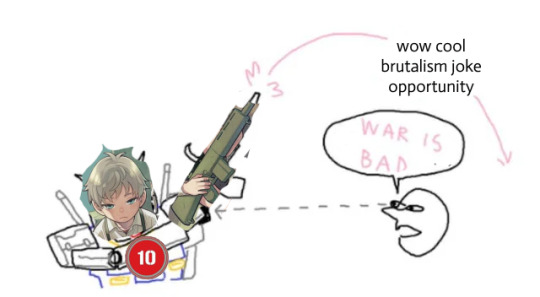
Volume 10: brutalism, whose name comes from the french 'beton brut' meaning raw concrete and frequently incorporates concrete and rebar as design materials, was in several ways a rejection of the modernist movement that could have been said to only have been made possible in part by post-war prosperity in 'allied' nations


Volume 11: Charles Rennie Mackintosh, Hill House Chair (Ladder Back Chair [for White Bedroom], 1902-04/1973), Glasgow school glasu


Volume 12: Harry Bertoia for Knoll, Diamond Chair (1952), MCM/industrial knoll wikipedia

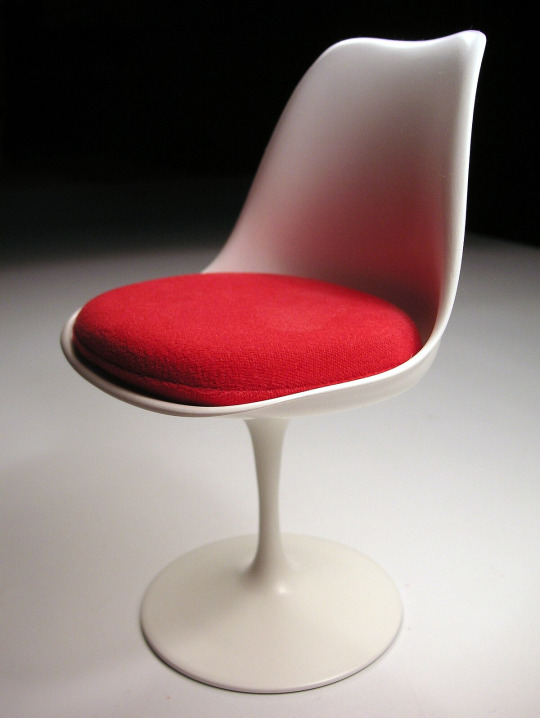
Volume 13: Eero Saarinen for Knoll, Tulip Chair (Tulip Side Chair, 1955), industrial/proto-space age wikipedia knoll


Volume 14: Frank Lloyd Wright for The Robie House, Robie Chair (Dining Table Side Chair, 1907-1910) smartmsm
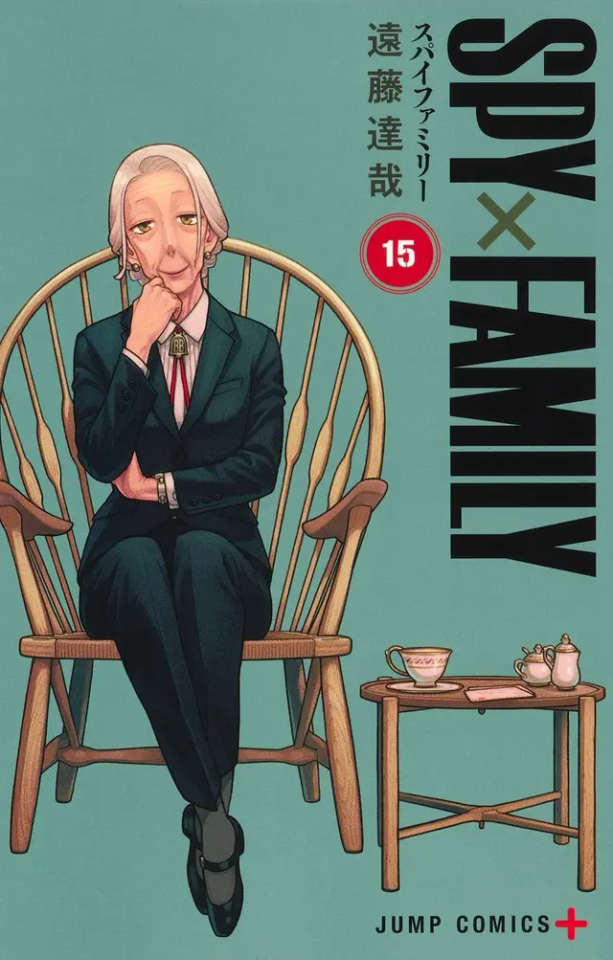
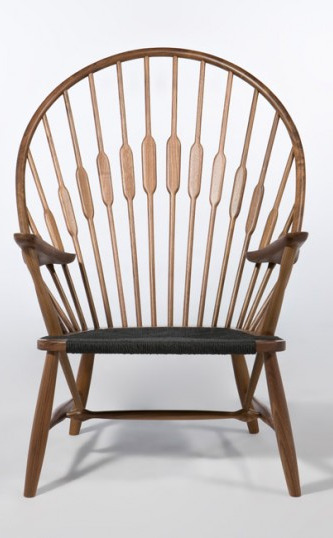
Volume 15: Hans Jørgensen Wegner for Johannes Hansen, Peacock Chair (Påfuglestolen/PP50, 1947) wikipedia
#spy x family#design#interesting that the family cutouts were added to the M in the english release of the tankos. often they do improve logos#like claymore. yeesh the original claymore logo sucks. someone needed to tell yagi that all caps medieval script looks like ass#everyone surrounding endo like the bart simpson meme waiting for him to do the stacking panton chair#also it looks like the kerning for the letters is adjusted. little things#almost all my image descriptions disappeared when I added volume 15 so. I can come back to that later.#good post good post
300 notes
·
View notes
Text
Art Brut time
Also this rant will proceed in two parts:
First, there is the history of architecture specifically. This is how Brutalism comes to be what it is and also why it is the boogeyman in everyone's closet. I want to convince you to entertain the idea that Brutalism is both good in and of itself and confused with other styles, while exploring the following question:
Can something as basically structural as architecture be "queer" or "outsider" in a meaningful sense?
I don't want to answer that question for you, because I'm more interested in it as a prompt.
Second, there is the history of Fascism. this interweaves with art history in a number of key ways as the movement evolves. I will here be talking about historical fascism from 1918 to 1945, and limit discussion of other authoritarian and totalitarian forms of government. I want to convince you that brutalism is opposed to and emerges historically against that historical fascism, independent of its relationship to other authoritarian structures, and explore the following question:
What function does aesthetic play in our sense of good and evil? Why do we "know" that the bad guys live in the concrete megastructure?
Again, not a question I want to answer authoritatively.
More to come.
45 notes
·
View notes
Text









↪[Favourite artists 18/???] Louis William Wain, (5 August 1860 – 4 July 1939) Nationality: British. Movement: Art Nouveau, Outsider art (Art brut)
#cats#cat art#art nouveau#Louis Wain#artists#animal art#cute cat#cat illustration#cat painting#pets#cat drawing#cat doodle#watercolour#coloured pencil#storybook illustration#storybook#anthro cat#anthropomorphic#anthropomorphic cats#fav artists
8 notes
·
View notes
Text
An ‘Ism’ Overview - Raw Art vs. Pop Art
In the 20th century, two movements emerged in the art world that challenged traditional notions of what art should look like: Raw art and Pop art. While Raw art celebrated the spontaneous and untrained creativity of outsider artists, Pop art celebrated the commercial and mass-produced culture of the 1950s and 60s. Despite their apparent differences, both Raw art and Pop art shared a common goal: to democratize the art world and make art accessible to a broader audience.
Raw art, also known as Outsider art or Art Brut, originated in the 1940s and 50s and was championed by artists like Jean Dubuffet. Raw art rejected the elitism and academicism of the art world and instead celebrated the work of untrained, self-taught artists who created art from their own inner worlds. These artists often used unconventional materials and techniques and were inspired by their own personal experiences rather than the dominant art movements of their time.
In contrast, Pop art emerged in the 1950s and 60s and celebrated the mass-produced, commercial culture of post-war America. Pop artists like Andy Warhol and Roy Lichtenstein used images and objects from popular culture, such as advertisements, comic books, and everyday objects, to create their art. They sought to blur the boundaries between high and low culture and to challenge the idea that art had to be serious and intellectual.
Despite their differences, both Raw art and Pop art were subversive movements that challenged the status quo. Raw art rejected the traditional standards of art-making, while Pop art challenged the idea that art had to be original and expressive. Both movements sought to democratize the art world and to make art accessible to a broader audience.
One key difference between Raw art and Pop art, however, is their relationship to authenticity. Raw art celebrated the authenticity of the artist's personal experience, while Pop art celebrated the authenticity of mass-produced images and objects. Raw art was often raw and unpolished, while Pop art was often slick and polished.
Another difference between the two movements is their relationship to the art establishment. Raw art rejected the art establishment and its elitism, while Pop art sought to critique and subvert it from within. Pop artists like Warhol and Lichtenstein gained commercial success and critical acclaim, blurring the boundaries between high and low culture, while Raw artists remained on the margins of the art world.
In conclusion, Raw art and Pop art may seem like two very different movements, but they shared a common goal of democratizing the art world and making art accessible to a broader audience. While Raw art celebrated the personal authenticity of outsider artists, Pop art celebrated the authenticity of mass-produced images and objects. Both movements challenged traditional notions of what art should look like and sought to create a more inclusive and diverse art world.
4 notes
·
View notes
Text
Releasing Today, Mar 4 2024!
Space Will is a topdown action roguelike where you build a ship with grid based bits. It's like the board game Galaxy Trucker had a video game child.
Afterworld is a neat RPGMaker game where you explore the afterworld and collect animal spirits. I like that it uses its own art assets.
The Gauntlet is an FPS precision platformer. I like the solid bright colors and like the TV show theming.
Bullet Bunny is a rogue-like twin stick shooter with sprite art. There's a bit too much going on in the screenshots for me, but I know other people like these.
Hazy Mind is a psychological horror visual novel about someone who woke in their up with no memories. Read the mature content description, there's some dark territory trodden here.
I may or may not be legally obligated to like games with names in the sixties - but Sixty Four has a lot going for it. It's like a combination of a clicker and a strategy building game like Factorio. I like that it has some kind of story that explains why (or at least I hope it tries to) there are machines and weird rocks, and cubes in the void. It might need an invert colors button if it doesn't have one though.
#game release#indie games#steam#spotlight#space will#afterworld#the gauntlet#bullet bunny#hazy mind#sixty four
2 notes
·
View notes
Text
I feel that theres a lot of art movements such as fauvism or post-impressionism or art brut or expressionism or probably a whole lot more that in not well versed in that fit VERY well into Tumblr's whole ideology atm.
#ignore the fact that most of these are from the same time period but then again. of that was the time of the abandonment of traditional art#and the rise of uneducated or emotion-based art that requects authority#well i think that fits very well into the current tumblr landscape#PARTICUARLY outsider art#i just want to grab it by the scruff of its neck and show it to everybody#oh also this is completely off topic but i feel that Maud Madsen's work would strike a lot chords here#rejects*#idk i could be not correct but these are the vibes i get
2 notes
·
View notes
Text
I also want to mention that AI art isn't the only one democratizing art ??
Namely the naive art movement and art brut (litteralt raw art), who were both characterized by art that was made by people with no art training (they didn't care about perspective or anatomy) and would often even emulate child drawings. Art brut would work with zero cultural references or knowledge
Some visuals :
Adolf Wölfli's Irren-Anstalt Band-Hain, 1910

Jean Dubuffet, Group of Four Trees (1972) pictured in April 2023

Also the villa Falbala because I love it

I'm also adding this article about self-taught artists because, once again, you can be a famous artist with no formal training : https://www.contemporaryartissue.com/top-10-self-taught-artists-of-the-contemporary-era/
Tldr : artists have been saying for decades if not more that art should be for everyone regardless of if they went through art school or not, and many famous ones didn't go or dropped out themselves
Can't afford art school?
After seeing post like this 👇

And this gem 👇
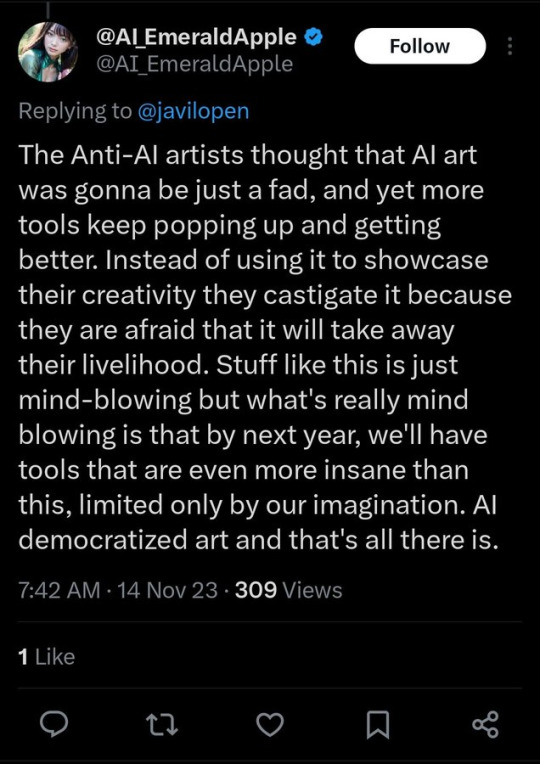
As well as countless of others from the AI generator community. Just talking about how "inaccessible art" is, I decided why not show how wrong these guys are while also helping anyone who actually wants to learn.
Here is the first one ART TEACHERS! There are plenty online and in places like youtube.
📺Here is my list:
Proko (Free)
Marc Brunet (Free but he does have other classes for a cheap price. Use to work for Blizzard)
Aaron Rutten (free)
BoroCG (free)
Jesse J. Jones (free, talks about animating)
Jesus Conde (free)
Mohammed Agbadi (free, he gives some advice in some videos and talks about art)
Ross Draws (free, he does have other classes for a good price)
SamDoesArts (free, gives good advice and critiques)
Drawfee Show (free, they do give some good advice and great inspiration)
The Art of Aaron Blaise ( useful tips for digital art and animation. Was an animator for Disney)
Bobby Chiu ( useful tips and interviews with artist who are in the industry or making a living as artist)
Second part BOOKS, I have collected some books that have helped me and might help others.
📚Here is my list:
The "how to draw manga" series produced by Graphic-sha. These are for manga artist but they give great advice and information.
"Creating characters with personality" by Tom Bancroft. A great book that can help not just people who draw cartoons but also realistic ones. As it helps you with facial ques and how to make a character interesting.
"Albinus on anatomy" by Robert Beverly Hale and Terence Coyle. Great book to help someone learn basic anatomy.
"Artistic Anatomy" by Dr. Paul Richer and Robert Beverly Hale. A good book if you want to go further in-depth with anatomy.
"Directing the story" by Francis Glebas. A good book if you want to Story board or make comics.
"Animal Anatomy for Artists" by Eliot Goldfinger. A good book for if you want to draw animals or creatures.
"Constructive Anatomy: with almost 500 illustrations" by George B. Bridgman. A great book to help you block out shadows in your figures and see them in a more 3 diamantine way.
"Dynamic Anatomy: Revised and expand" by Burne Hogarth. A book that shows how to block out shapes and easily understand what you are looking out. When it comes to human subjects.
"An Atlas of animal anatomy for artist" by W. Ellenberger and H. Dittrich and H. Baum. This is another good one for people who want to draw animals or creatures.
Etherington Brothers, they make books and have a free blog with art tips.
As for Supplies, I recommend starting out cheap, buying Pencils and art paper at dollar tree or 5 below. For digital art, I recommend not starting with a screen art drawing tablet as they are more expensive.
For the Best art Tablet I recommend either Xp-pen, Bamboo or Huion. Some can range from about 40$ to the thousands.
💻As for art programs here is a list of Free to pay.
Clip Studio paint ( you can choose to pay once or sub and get updates)
Procreate ( pay once for $9.99)
Blender (for 3D modules/sculpting, ect Free)
PaintTool SAI (pay but has a 31 day free trail)
Krita (Free)
mypaint (free)
FireAlpaca (free)
Libresprite (free, for pixel art)
Those are the ones I can recall.
So do with this information as you will but as you can tell there are ways to learn how to become an artist, without breaking the bank. The only thing that might be stopping YOU from using any of these things, is YOU.
I have made time to learn to draw and many artist have too. Either in-between working two jobs or taking care of your family and a job or regular school and chores. YOU just have to take the time or use some time management, it really doesn't take long to practice for like an hour or less. YOU also don't have to do it every day, just once or three times a week is fine.
Hope this was helpful and have a great day.
99K notes
·
View notes
Text

Art brut, bruta tú, 100mg es un dispositivo, un artefacto para cuestionar el art brut desde un enfoque diferente, como violencia ejercida y no proceso admirable a favor de las psiquiatrizadas. Por otro lado, quiere ser también una defensa del movimiento político de las supervivientes de la psiquiatría, y de su papel como sujetos políticos y artistas. Pero, además, es una invitación a cambiar dichas lógicas, no solo sobre la salud mental, la locura (la manera en que la entendemos) sino también, las lógicas del mundo del arte, de sus instituciones y enfoques.
Art brut, bruta tú 100mg nace del proyecto Cómo conseguimos que nos dejen en paz elaborado por Fátima Masoud y Castillo durante la residencia que realizaron en La Escocesa en Barcelona en 2022. El libro fué producido e impreso en el taller de risografía de La Escocesa a manos de Marian Vélez, con texto y dibujos de Fátima Masoud y diseñado por Valentina Alvarado Matos.
Fátima Masoud vive en Madrid y es investigadora, artista y activista en “salud mental”. Es una de las fundadoras del colectivo Orgullo Loco Madrid. Ha participado en la organización del Día del Orgullo Loco en Madrid, cada año, desde 2018. Formó parte de la organización del Orgullo Loco Radikal Estatal, en 2024 en Bilbao. Es impulsora del proyecto Locas por los Libros y de La Bajona Colectiva. Ha escrito varios artículos y ha dado varias charlas sobre la psiquiatrización y el movimiento del Orgullo Loco. Desde 2020 ha participado en el proyecto: One-year research in the frame of the Fonds de la Recherche en Art (FRArt): Experimental and collaborative artistic research on queer collective approaches to harm reduction and the act of gathering En 2022 realizó junto a Castillo, una residencia en La Escocesa de Barcelona con el proyecto “Cómo conseguimos que nos dejen en paz”. En 2023 escribe el fanzine Art brut, bruta tú 100mg en Ediciones La Escocesa, sobre la tutela y el expolio de las personas psiquiatrizadas en el mundo del arte, y que fue presentado en CA2M. Investiga, escribe, pinta y sigue sobreviviendo al sistema psiquiátrico.
***
Art brut, brute you, 100mg is a device, an artifact to question the art brut from a different approach, as violence exercised and not an admirable process in favor of the people psychiatrized. On the other hand, it also wants to be a defense of the political movement of the survivors of psychiatry, and of their role as political subjects and artists. But it is also an invitation to change these logics, not only about mental health, madness (the way we understand it) but also the logics of the art world, its institutions and approaches.
Art brut, bruta tú 100mg is born from the project Cómo conseguimos que nos conseguimos que nos dejen en paz elaborated by Fátima Masoud and Castillo during the residency they did at La Escocesa in Barcelona in 2022. The book was produced and printed at La Escocesa's risography workshop by Marian Vélez, with text and drawings by Fátima Masoud and designed by Valentina Alvarado Matos.
Fatima Masoud lives in Madrid and is a researcher, artist and “mental health” activist. She is one of the founders of the Orgullo Loco Madrid collective. She has been involved in the organization of the Orgullo Loco Day in Madrid, every year, since 2018. She was part of the organization of the Orgullo Loco Radikal Estatal, in 2024 in Bilbao. She is the driving force behind the project Locas por los Libros and La Bajona Colectiva. She has written several articles and has given several talks on psychiatrization and the Pride Loco movement. Since 2020 she has participated in the project: One-year research in the frame of the Fonds de la Recherche en Art (FRArt): ‘Experimental and collaborative artistic research on queer collective approaches to harm reduction and the act of gathering’. In 2022 she realized, together with Castillo, a residency at La Escocesa in Barcelona with the project “How do we get them to leave us alone”. In 2023 she wrote the fanzine Art brut, bruta tú 100mg in Ediciones La Escocesa, about the tutelage and plundering of psychiatrized people in the art world, which was presented at CA2M. She researches, writes, paints and continues to survive the psychiatric system.
0 notes
Text
youtube
* Let’s hear it for the Art Brut Movement!
Birthday Remembrances. Today, July 31, 1901 – #JeanDubuffet, French painter and sculptor (d. 1985) was born.
( https://en.wikipedia.org/wiki/Jean_Dubuffet )
0 notes
Text
昨日描いたもの。
浮かんだまま描きました。
This is what I drew yesterday.
I painted as it came to me.
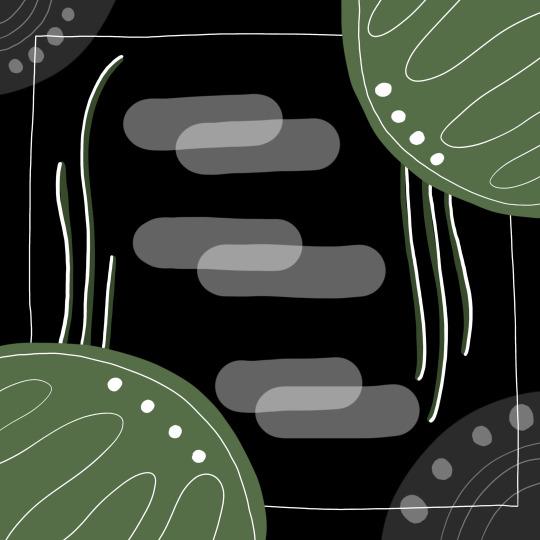
#統合失調症#リハビリ#思考のリハビリ#アウトサイダーアート#アール・ブリュット#art brut (art movement)#outsider art#schizophrenia#rehabilitation#Thought Rehabilitation
3 notes
·
View notes
Text





Chrysalis premiere 11.12.13. March 2024 studio brut / imagetanz festival
By fusing the animated and the inanimate, Yoh Morishita’s performance Chrysalis creates an incarnation of the absurd. We see a body infested with a variety of materials: mussels, horn, tentacles, synapses, tubers, claws, and rhizomes. This body is mutating all the time, nothing ever fits together. And it withstands the forces eager to eliminate diversity. It eludes oppression by altering its shape or slipping away from it altogether and leaving behind only skin. Like a pupated insect about to hatch.
In Chrysalis, Yoh Morishita ponders on how organisms and people change. She embodies a process of metamorphosis that perceives life as a dynamic equilibrium. Different types of movement appear simultaneously at the various body parts, creating a fatuous coherence of the animated and the inanimate. Existing orders are constantly being dissolved and created anew. Where will this slowly evolving sequence of images lead us? If change is the essence of life, how much do we allow ourselves to change? How do we feel about strange beings and objects? And who are ‘we’ anyway?
Chrysalis addresses and processes various questions around change. Lithuanian artist/composer Marija Jociūtė creates an electronic soundscape for the piece that inspires communication between all those involved. An uncanny world looms before us!
Concept and performance Yoh Morishita Live sound and music Marija Jociūtė Lighting design Leo Kuraitė Costume design Lisa Knoll Outside eye and ear Camilla Schielin, Julia Müllner, Magdalena Forster, Dominik Morishita-Leitner
A co-production of Yoh Morishita, brut Wien and Im_flieger. With the kind support of the Austrian Federal Ministry of Art, Culture, Civil Service and Sport, and ImPulsTanz Atlas program.
0 notes
Text
Art Brut - Live At Summer Sundae 2005 - Past Daily Soundbooth.
Art Brut – tagged one of the seminal bands of the Art Wave movement. https://pastdaily.com/wp-content/uploads/2023/09/Art-Brut-Live-at-Summer-Sundae-2005.mp3 Art Brut – live at Summer Sundae – 2005 – August 13, 2005 – BBC 6 Music – Art Brut for a Thursday night – recorded live during the Summer Sundae 2005 Festival on August 13, 2005 and broadcast by BBC 6 Music. Art Brut’s debut album, Bang…

View On WordPress
0 notes
Text
An ‘Ism’ Overview – Outsider Art vs. Dadaism
I have always been fascinated by the ways in which artists push the boundaries of what is considered acceptable or mainstream. Two movements that have particularly intrigued me are Outsider Art and Dadaism. Although they emerged in different times and contexts, these movements share a common thread of rebellion against traditional artistic norms. In this essay, I will compare and contrast Outsider Art and Dadaism, examining the similarities and differences between these two groundbreaking movements.
Outsider Art, also known as Art Brut, refers to art created by individuals who are self-taught or outside the mainstream art world. Outsider artists often work in isolation, using unconventional materials and techniques to express their personal visions. The term “Outsider Art” was coined by French artist Jean Dubuffet in the 1940s, who believed that these artists had an authentic and pure approach to creativity that was not tainted by the influence of established artistic traditions.
Dadaism, on the other hand, emerged in Europe during World War I as a response to the absurdity and horror of war. Dada artists rejected traditional aesthetic values and instead embraced chaos, nonsense, and anti-art. The movement’s name is derived from the French word “dada,” which means “hobbyhorse” or “child’s toy,” reflecting its playful and irreverent spirit.
Despite their differences in origin and philosophy, Outsider Art and Dadaism share a number of similarities. Both movements sought to challenge established artistic norms and to push the boundaries of what was considered acceptable or “normal” in art. Both were characterized by a rejection of conventional aesthetics in favor of more experimental and unconventional approaches. And both movements were driven by a desire to express personal visions that were not necessarily rooted in external reality.
At the same time, there are also some notable differences between Outsider Art and Dadaism. One of the key differences is that Outsider Art is often deeply personal and expressive, reflecting the inner worlds of the artists who create it. By contrast, Dadaism is more concerned with undermining and subverting existing social and artistic structures, and its works often have a more confrontational and satirical edge.
Another difference is that Outsider Art often emerges from a place of isolation or marginalization, while Dadaism was a deliberately collective movement that sought to disrupt and transform the social and cultural landscape of its time. Outsider artists often work alone, using whatever materials and techniques are available to them, while Dada artists worked collaboratively and often engaged in public performances and protests.
In conclusion, Outsider Art and Dadaism are two fascinating and important artistic movements that share a common impulse towards rebellion and experimentation. Both movements have had a profound impact on the course of 20th-century art and continue to inspire and challenge artists today. While their differences are significant, they ultimately represent different facets of the same impulse towards creative freedom and individual expression that lies at the heart of all great art.
3 notes
·
View notes
Text
losing face
// own work dance performance
+ art direction, concept, choreography + dance & performance
losing face by Cat Jimenez in collaboration with Imani Rameses, Sebastian Youngung Kim, Miranda Rumerstorfer
vimeo
losing face takes a deep dive into the convoluted interweavings of the colonial mindset. Compliance is but a small price to pay for an illusion of a quiet existence, but when does existence become submission?
Four non-white performers from a variety of movement backgrounds negotiate their place in a predominantly white country - a supposed harmony. Yet, the living portrayal of harmony invites more dissonance making the lullaby of indifference an enchanting tune. Are the performers able to unlearn and untangle oneself from being made to feel less? The more one tries to save face one loses it even more.
losing face dances through contradictions of colored truths, negotiating the rhythms of an undeniable urgency.
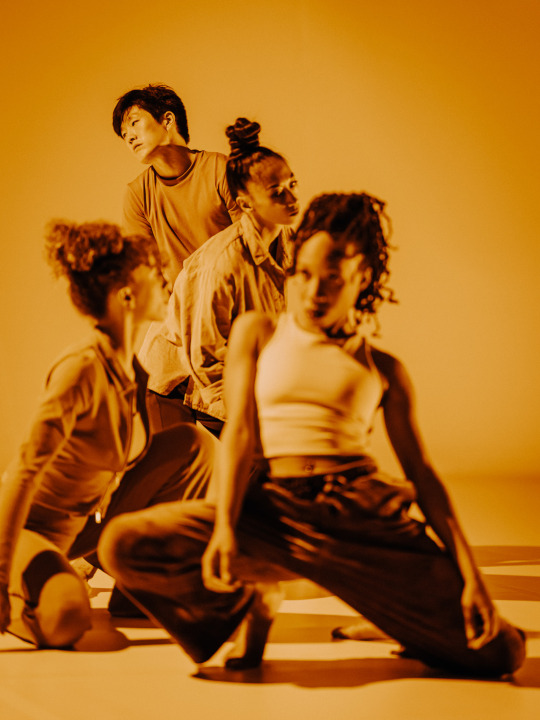
Credits:
Art direction, concept, choreography / Cat Jimenez Co-conception Co-conception, artistic collaboration / Imani Rameses Co-choreography, performance / MirandaRumerstorfer, Youngung Sebastian Kim, Imani Rameses, Cat Jimenez Dramaturgy, Coaching / Philippe Riéra Musical direction, composition / Martin Mitterstieler Lighting design / Veronika Mayerböck Styling / Magdalena Neuburger Outside eye / Jaskaran Singh Anand Head of production, outside eye / Franziska Zaida Schrammel
A co-production by KV Amygdala Wien and imagetanz/brut Wien
With the kind support of the City of Vienna’s Department of Cultural Affairs, the Federal Ministry of Art, Culture, Civil Service and Sport and Sport and Bildrecht (SKE Fonds).
Supported by SZENE Salzburg, Breakin’ Convention London, Bears in the Park and Tanz Company Gervasi (Raum 33).
Special thanks to Body Consulting / Sebastian Baumann, Physiotherapy / Sophia Kahlhammer, Text contribution / Gerard Rabara and Allround support / Michaela Altweger.
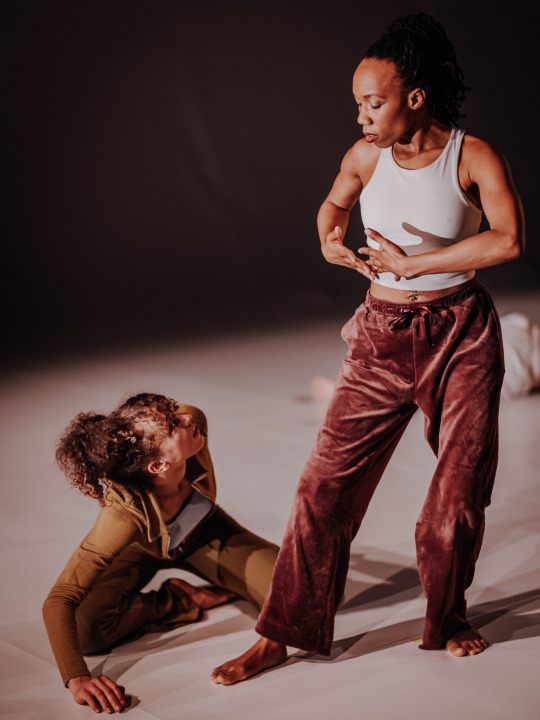

definitions
Colonial mindset A condition in which an oppressed individual or group comes to believe that they are inferior to those in power or who are part of the dominant group. Colonial mindset is a form of internalized oppression.
Internalized oppression, or internalized colonialism, is a concept in which an oppressed group uses the methods of the oppressor against itself. It occurs when one group perceives an inequality of value relative to another group, and desires to be like the more highly-valued group.
Lateral oppression, or lateral violence, is displaced violence directed against one’s peers rather than adversaries.
examples
- as BIPoC in a predominantly white country voting for the right wing party - the promotion of whitening cream as being “clean” within black and/or brown communities - the belief of the own culture as being vulgar and/or ignorant in pre-colonial times - agreeing to physical/verbal violence directed to one's own community - and many more….
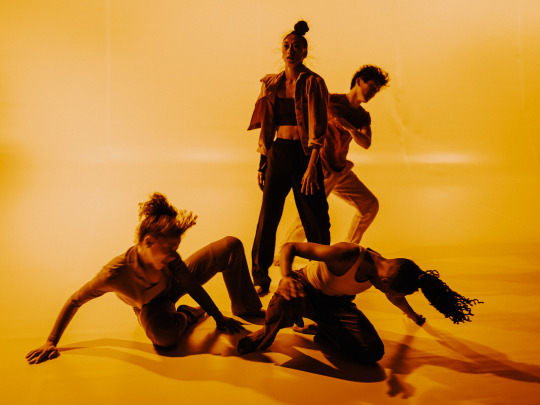
0 notes
Text
Brutalism
Brutalism is an architectural style that places emphasis textures, materials, construction, expression, practicality, and utilitarianism. The style is often characterised by its rough textures, hard edges, rigid geometric shapes, blocky appearances, lack of decoration, simple graphic lines, monochromatic colour palette, and an almost monolithic sense of presence. Scale was a large aspect of brutalist architecture. In addition, brutalism made use of unusual shapes that can easily be differentiated through the use of light and shadow (contrast). Brutalism is memorable and takes up space. Think of a skyscraper: its immense size, the way it takes up space in the open sky, and the way it forever alters your view of the skyline.
Common materials used in brutalist architecture include raw concrete (its most important stylistic motif), brick, glass, steel, and stone.
The term ‘Brutalism’ is derived from the phrase ‘Béton brut,’ which means raw concrete. Brutalist architecture can be observed as far back as the 1940s, with the first example being Le Corbusier’s Unité d’Habitation in Marseilles, France.
The style emerged during the 20th century modernist movement, with the term first being coined in 1949 by Swedish architect Hans Asplun to describe the Villa Göth in Uppsala. The term was then popularised in 1955 when it was used by architectural historian Reyner Banham, when reviewing a school at Hunstanton, Norfolk.
The style grew in popularity through the 1950s and ‘60s, and became the favoured form of architecture for government buildings.
Brutalism as a philosophy focused on bringing modern, developed, almost utopian environments to life. This was a post-WWII era, where urban reconstruction was a pressing matter. Many of the European cities were damaged by bombs and the end of a World War meant a population boom for the US and Europe. This meant that architects needed to design large scale institutional buildings as well as high density affordable residential complexes. The 1950s and 60s was also a time of great technological and social development, creating this culture of optimism and hope for a better future. This zeitgeist was reflected in brutalism; with the movement focusing on functionality and community, and becoming synonymous with socially progressive housing plans that depicted the modern utopian buildings of the future.
Brutalism eventually fell out of style in the 1980s and ‘90s, when the architecture became associated with urban decay, crime, social depravity, economic hardship, and anti-environmentalism. This was partially due to the fact that the raw concrete did not age well, often being prone to decay and water damage. The style also began to be seen as cold, alienating, and lacking in humanity. In addition, due to the architecture being adopted by the Soviet Union, the style began to become associated with totalitarianism, dictatorship, and social control/conformity. This was the period of the Cold War, and therefore the height of the Red Scare, thus creating a widespread fear of communism in the west that Brutalism unfortunately suffered from.
The Brutalist Playground (2015)
Simon Terrill collaborated with Assemble to create a brutalist art installation that “recreated a trio of post-war play structures out of foam.” The installation was displayed at the Royal British Institute of British Architects gallery. The playground was inspired by the Churchill Gardens in Pimlico, the Brownfield Estate in Poplar, and the Brunel Estate in Paddington. Terrill recreated these structures using colourful foam.
Simon Terrill
Simon Terrill is an Australian artist based in London who is preoccupied by the relationship between architecture and the narratives and stories we construct around these spaces. He explores how spaces are constructed and informed by the people that inhabit it.
This greatly relates to our study of heterotopias, as a primary characteristic of heterotopias is how it is constructed as a closed off space for specific social functions, and how it changes over time as society changes around it.
0 notes